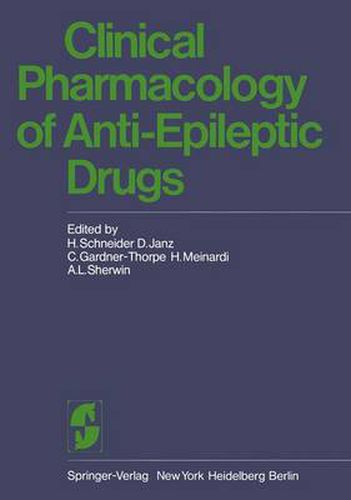Readings Newsletter
Become a Readings Member to make your shopping experience even easier.
Sign in or sign up for free!
You’re not far away from qualifying for FREE standard shipping within Australia
You’ve qualified for FREE standard shipping within Australia
The cart is loading…






This title is printed to order. This book may have been self-published. If so, we cannot guarantee the quality of the content. In the main most books will have gone through the editing process however some may not. We therefore suggest that you be aware of this before ordering this book. If in doubt check either the author or publisher’s details as we are unable to accept any returns unless they are faulty. Please contact us if you have any questions.
He who is faithfully analysing … epi lepsy is doing far more than studying epilepsy Hughlings Jackson Modifying this well-known statement by Jackson, one could say today: He who is faithfully analysing anti-epileptic drugs is doing far more than studying anti-epileptic drugs . For these drugs not only serve to prevent epileptic fits and thus advance the treatment of epilepsy, they are also effective in the treatment of cardiac arrhythmias and trigeminal neuralgia. Furthermore, clinical pharmacologists consider anti-epi leptic drugs as model drugs in pharmacokinetics and pharmocodynamics, since reliable methods are available for their determination and their effects and side effects can be defined. The methods of estimating of drugs in body fluids provide a tool that enables us to throw light on many obscure relationships in pharmaceutical treatment. Now that we can study the pharmacokinetics and interaction of drugs in man, many hypotheses based on clinical experience alone may well be eliminated or corroborated. The grow ing body of knowledge will make us more careful about the administration of drugs in combination. Now that we can study how biological parameters interfere with drug action, we may perhaps proceed to the scientific analysis of many clinical observations that suggest the importance of such factors as age, sex, menstrual cycle, pregnancy, fever, diet, stress, sport, climate, and altitude.
$9.00 standard shipping within Australia
FREE standard shipping within Australia for orders over $100.00
Express & International shipping calculated at checkout
This title is printed to order. This book may have been self-published. If so, we cannot guarantee the quality of the content. In the main most books will have gone through the editing process however some may not. We therefore suggest that you be aware of this before ordering this book. If in doubt check either the author or publisher’s details as we are unable to accept any returns unless they are faulty. Please contact us if you have any questions.
He who is faithfully analysing … epi lepsy is doing far more than studying epilepsy Hughlings Jackson Modifying this well-known statement by Jackson, one could say today: He who is faithfully analysing anti-epileptic drugs is doing far more than studying anti-epileptic drugs . For these drugs not only serve to prevent epileptic fits and thus advance the treatment of epilepsy, they are also effective in the treatment of cardiac arrhythmias and trigeminal neuralgia. Furthermore, clinical pharmacologists consider anti-epi leptic drugs as model drugs in pharmacokinetics and pharmocodynamics, since reliable methods are available for their determination and their effects and side effects can be defined. The methods of estimating of drugs in body fluids provide a tool that enables us to throw light on many obscure relationships in pharmaceutical treatment. Now that we can study the pharmacokinetics and interaction of drugs in man, many hypotheses based on clinical experience alone may well be eliminated or corroborated. The grow ing body of knowledge will make us more careful about the administration of drugs in combination. Now that we can study how biological parameters interfere with drug action, we may perhaps proceed to the scientific analysis of many clinical observations that suggest the importance of such factors as age, sex, menstrual cycle, pregnancy, fever, diet, stress, sport, climate, and altitude.